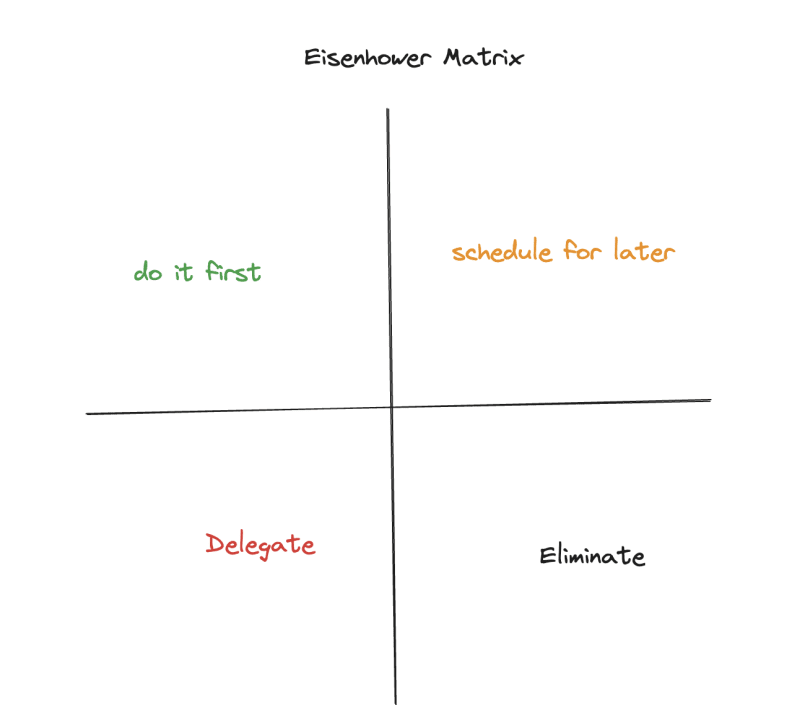In the midst of our busy daily lives, staying organized and efficient can be a real challenge. Whether you're a professional juggling numerous responsibilities or simply trying to strike a balance between work and personal life, finding a system to prioritize tasks effectively is crucial. One such system that has transformed the way I approach my daily routine is the Eisenhower Matrix.
My journey with the Eisenhower Matrix began on a flight to NJ for a customer meeting. During the flight, my boss/mentor shared some valuable advice, saying, "Angu, you should learn how to use your time effectively, understanding what tasks you should do and what tasks you can delegate to others." His words got me thinking about how I could improve my daily tasks and make the most out of my time.
It was during this moment of reflection that I stumbled upon the Eisenhower Matrix through a random search. Without hesitation, I started crafting my own Eisenhower Matrix right then and there, and I've been refining and utilizing it ever since. It has proven immensely valuable in enhancing my productivity and time management. Now, I want to share my personal Eisenhower Matrix with you in the hope that it can bring similar benefits to your life.
The Eisenhower Matrix: A Brief Overview
The Eisenhower Matrix, a task management technique, offers a systematic way to categorize and prioritize your tasks based on their urgency and importance. This matrix helps you determine which tasks to tackle immediately, schedule for later, delegate, or eliminate. In this article, we'll guide you through the process of setting up an Eisenhower Matrix and share valuable tips for effective task prioritization.
Urgent and Important (Do First):
Team Daily Stand-up: This is the heartbeat of our team's coordination. Understanding where we stand on our deliveries is not just important but urgent to ensure we're on track.
Critical Deliverable Tasks: Staying on top of critical deliverables is imperative to meet project deadlines and maintain our reputation for excellence.
Support Ticket: Immediate attention to support tickets is crucial to provide timely assistance to our clients and maintain their satisfaction.
JIRA Board: Keeping an eye on our project management board helps ensure that the number of bugs and re-open tickets remains under control.
Internal and External Stakeholder Meetings: These meetings are essential for project progress and maintaining strong client relationships.
Address Team Member Issues: As a team leader, addressing team member issues promptly is both urgent and important for team morale and productivity.
Spending Time with Family and Friends: Quality time with loved ones is not just important but also urgent for maintaining personal well-being and healthy relationships.
Important but Not Urgent (Schedule):
Strategic Planning: Allocating time for strategic planning ensures we have a clear path forward for long-term project success.
Skill Development: Regularly scheduled skill development sessions help me stay ahead in my field and provide better guidance to my team.
Relationship Building: Networking and relationship-building activities are vital for career growth and expanding our professional network.
Personal Development: Setting aside time for personal development allows for self-improvement and growth, contributing to long-term success.
Health and Wellness: Regularly scheduling time for exercise and health check-ups ensures I remain fit and energized to tackle daily challenges.
Writing Blog: Allocating time for blog writing allows me to share insights and connect with a broader audience, contributing to my personal and professional growth.
Urgent but Not Important (Delegate):
Onboarding: Delegating the onboarding process to HR or designated team members frees up my time to focus on other critical tasks.
Non-Essential Meetings: Delegating attendance at non-essential meetings to team members ensures that my presence is reserved for meetings where my input is essential.
Deployment and Operations: Assigning deployment and day-to-day operations tasks to capable team members allows me to concentrate on high-priority matters.
Ordering Take-Out Food: Delegate the responsibility of selecting and ordering take-out food to other household members or colleagues, allowing me to save time and focus on more important tasks.
Routine Development Tasks for New Joinees: Assign routine development tasks for new employees to team mentors or trainers to ensure a smooth onboarding process, allowing you to focus on higher-level guidance and leadership.
Not Urgent and Not Important (Eliminate):
Excessive Social Media Usage and Web Browsing: Reducing non-work-related social media time helps eliminate distractions and increases productivity.
Unnecessary Email Checking: Minimizing the frequency of checking non-essential emails prevents distractions and allows for more focused work.
Unrelated Side Projects: Shelving or eliminating side projects that do not align with my goals prevents unnecessary diversions.
Conclusion
The Eisenhower Matrix has been helping in my daily routine. By categorizing tasks into these four quadrants, I've gained clarity on what needs my immediate attention, what can be scheduled for later, what can be delegated, and what should be eliminated altogether. This simple yet powerful matrix has not only increased my productivity but also reduced stress and improved my work-life balance.
I encourage you to create your own Eisenhower Matrix tailored to your unique responsibilities and goals. It's a versatile matrix that can help anyone take control of their time and focus on what truly matters. Remember, it's not about doing more; it's about doing the right things at the right time.







Top comments (0)